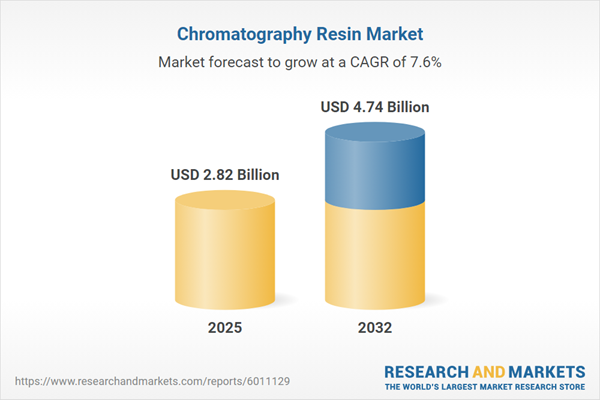Speak directly to the analyst to clarify any post sales queries you may have.
As regulatory frameworks tighten and digitalization transforms procurement, the chromatography resin market requires decision-makers to reassess sourcing strategies and compliance objectives. Staying ahead of supply and operational shifts calls for tailored intelligence and market-driven procurement guidance.
Market Snapshot: Chromatography Resin Market Overview and Trends
The chromatography resin market is valued at USD 2.63 billion in 2024, with projections reaching USD 2.82 billion by 2025 and anticipated to grow to USD 4.74 billion by 2032, representing a 7.62% CAGR. Sector growth is spurred by investment in advanced resin technologies, widespread adoption of innovative manufacturing techniques, and an intensified focus on supply chain resilience. Procurement leaders increasingly leverage digital solutions to streamline sourcing and respond to evolving regulatory requirements. These changing dynamics underscore the need for strategic insights and operational agility to ensure sustained competitiveness.
Scope & Segmentation of the Chromatography Resin Market
This report provides an executive-level review of the segmentation shaping chromatography resin procurement. Understanding segment trends offers valuable context for strategic purchasing and market benchmarking.
- Resin Types: Affinity, ion exchange, mixed-mode, size exclusion, and gel filtration resins are analyzed for their ability to address varied analytic demands and maximize process efficiency in both biopharmaceutical production and laboratory applications.
- Base Materials: Natural ingredients such as agarose and cellulose provide sensitivity for delicate processes, while synthetic polymers offer enduring performance and reliability in demanding operational settings.
- Applications: Coverage includes drug discovery, large-scale bioprocessing, diagnostic labs, and R&D settings, supporting increased productivity, enhanced yield, and process scalability with robust resin solutions.
- End Users: Academic institutions, biotechnology companies, CDMOs, and pharmaceutical manufacturers are considered, each with specialized requirements for supply assurance and compliance management.
- Sales Channels: Direct supplier relationships, distributors, and online procurement platforms are evaluated for their ability to provide timely access to both standard and custom resin products, meeting varied fulfillment needs.
- Regions Covered: The analysis spans North America, Latin America, Europe, Middle East, Africa, and Asia-Pacific, highlighting diverse regulatory expectations and procurement preferences across geographies.
- Companies Analyzed: Detailed profiles include Cytiva, Merck KGaA, Thermo Fisher Scientific, Sartorius AG, Repligen Corporation, Purolite Corporation, Tosoh Corporation, Bio-Rad Laboratories, and key regional providers, supporting a wide supplier comparison and innovative benchmarking.
Key Takeaways for Senior Decision-Makers
- Emerging therapeutic modalities are increasing the demand for precision chromatography resin solutions, aligned to stricter regulatory and operational safeguards.
- Adoption of regenerated and single-use resins is helping organizations advance sustainability initiatives and streamline validation across multiple production scenarios.
- Strategic selection between ion exchange and mixed-mode resins directly impacts process control, output reliability, and operational productivity.
- Synthetic polymers offer manufacturers adaptable and durable solutions to accommodate evolving production requirements, while natural bases remain essential for sensitive applications.
- Implementation of digital procurement tools accelerates sourcing decisions and enhances visibility across the resin supply landscape, providing risk mitigation during demand and policy fluctuations.
Tariff Impact on Chromatography Resin Procurement
Forthcoming U.S. tariffs in 2025 prompt procurement leaders to evaluate supplier portfolios and renegotiate contract terms to safeguard pricing stability and inventory continuity. Strengthening regional partnerships, diversifying supplier bases, and refining inventory strategies are critical for minimizing exposure to ongoing regulatory and policy changes.
Methodology & Data Sources
Report insights result from in-depth interviews with chromatography sector experts, procurement specialists, and R&D leaders. Data is further supported by peer-reviewed studies, current regulatory guidance, corporate filings, and detailed supply chain analytics to ensure practical and credible recommendations.
Why This Report Matters
- Provides procurement and executive teams with the ability to benchmark chromatography resin suppliers in the context of changing global regulatory demands and market standards.
- Enables informed, responsive adjustment to new resin technologies and compliance mandates, supporting adaptive and resilient sourcing strategies.
- Aligns sourcing, sustainability objectives, and inventory controls with operational needs and geographic market distinctions for more robust risk management and business continuity.
Conclusion
Executive teams gain the targeted insights required to refine chromatography resin strategies, improve supply reliability, and optimize workflows across a market defined by constant regulatory and operational change.
Additional Product Information:
- Purchase of this report includes 1 year online access with quarterly updates.
- This report can be updated on request. Please contact our Customer Experience team using the Ask a Question widget on our website.
Table of Contents
3. Executive Summary
4. Market Overview
7. Cumulative Impact of Artificial Intelligence 2025
Companies Mentioned
The companies profiled in this Chromatography Resin market report include:- Cytiva
- Merck KGaA
- Thermo Fisher Scientific Inc.
- Sartorius AG
- Repligen Corporation
- Purolite Corporation
- Tosoh Corporation
- Bio-Rad Laboratories, Inc.
- CliniSciences S.A.S
- Chemra GmbH
- Bio-Works Technologies AB
- DuPont de Nemours, Inc.
- GE Healthcare
- Kaneka Corporation
- Samyang Corporation
- Sepragen Corporation
- Triskem International
- VWR International, LLC
- YMC America
- Changzhou Smart-Lifesciences Biotechnology Co., Ltd.
- JSR Life Sciences, LLC
- Avantor, Inc.
- JNC CORPORATION
Table Information
| Report Attribute | Details |
|---|---|
| No. of Pages | 196 |
| Published | November 2025 |
| Forecast Period | 2025 - 2032 |
| Estimated Market Value ( USD | $ 2.82 Billion |
| Forecasted Market Value ( USD | $ 4.74 Billion |
| Compound Annual Growth Rate | 7.6% |
| Regions Covered | Global |
| No. of Companies Mentioned | 24 |









